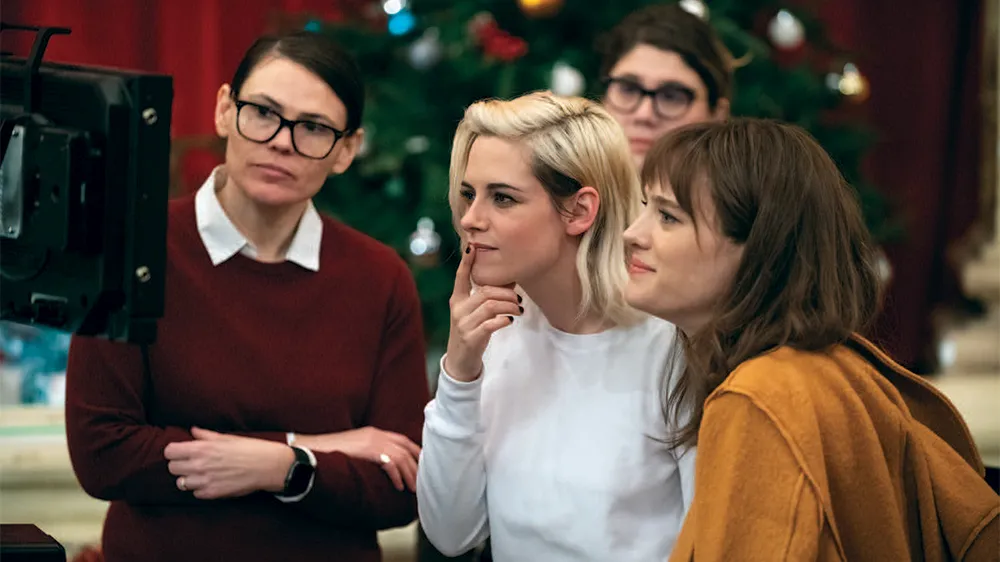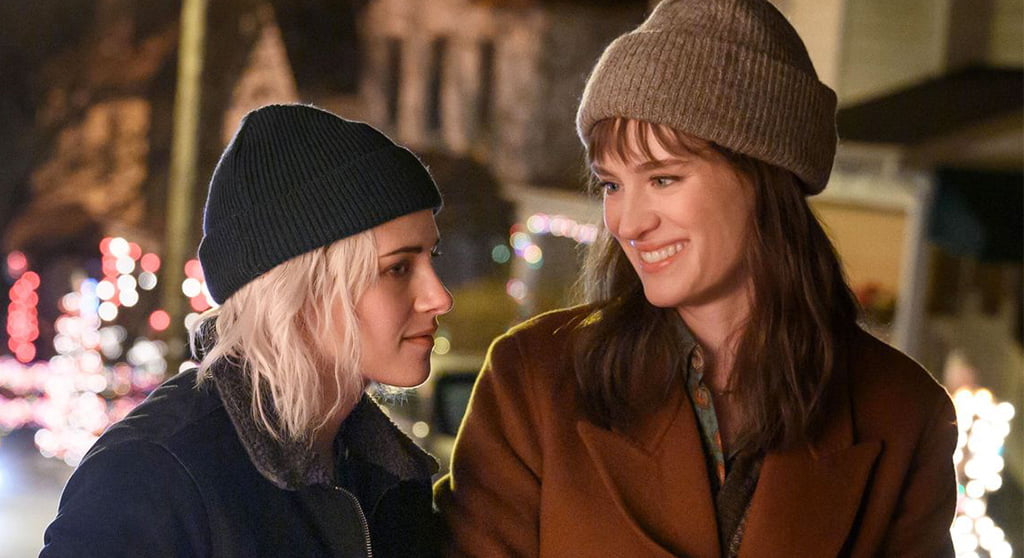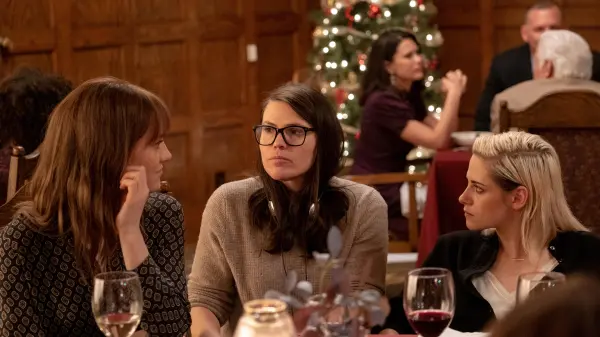‘Happiest Season,’ directed by Clea DuVall and released in 2020, stands out as a significant milestone in the genre of holiday romantic comedies. This film brings a refreshing narrative that centers around a lesbian couple, Abby and Harper, portrayed by Kristen Stewart and Mackenzie Davis, respectively. The plot unfolds as Abby plans to propose to Harper during a festive holiday visit to Harper’s family. However, complications arise when Abby discovers that Harper has not yet come out to her conservative parents.
The movie’s premise is both charming and challenging, encapsulating the complexities that can arise in romantic relationships, especially in the context of family dynamics and societal expectations. ‘Happiest Season’ not only provides ample moments of humor and romance but also delves into the emotional struggles of coming out and seeking acceptance. These themes resonate deeply with many LGBTQ+ individuals and their loved ones, making the film a poignant and relatable depiction of contemporary queer experiences.
What distinguishes ‘Happiest Season’ is its place as a mainstream holiday film that prioritizes a lesbian couple at its heart. Traditionally, holiday movies have often sidelined LGBTQ+ narratives, focusing instead on hetero relationships. ‘Happiest Season’ breaks this mold by showcasing a LGBT couple’s journey, thereby broadening the representation of love and relationships in popular media. This inclusivity not only enriches the genre but also fosters a more diverse and empathetic understanding of holiday traditions and family bonds.
Overall, ‘Happiest Season’ is more than just a festive romantic comedy; it is a culturally significant piece that contributes to the visibility and normalization of LGBTQ+ relationships in mainstream cinema. By telling Abby and Harper’s story, the film invites audiences to reflect on themes of love, acceptance, and the true meaning of family during the holiday season.

Plot and Characters
“Happiest Season” centers on the relationship between Abby (Kristen Stewart) and Harper (Mackenzie Davis), a couple navigating the complexities of love during the holiday season. The film begins with Abby planning to propose to Harper at Harper’s family Christmas gathering, only to discover that Harper has not yet come out to her conservative family. This revelation sets the stage for the central conflict of the movie, as Abby must grapple with Harper’s decision to conceal their relationship.
Harper’s family is a blend of distinctive personalities that contribute both tension and humor to the narrative. Her father, Ted (Victor Garber), is a politician running for mayor, which adds a layer of pressure for Harper to present a ‘perfect’ image. Her mother, Tipper (Mary Steenburgen), is an overbearing figure obsessed with maintaining family appearances. Harper’s siblings, Sloane (Alison Brie) and Jane (Mary Holland), further complicate the dynamic: Sloane, the overachiever, is embroiled in her own marital issues, while Jane, the quirky and oft-overlooked sister, brings a light-hearted touch to the family drama.
A significant aspect of “Happiest Season” is the support system Abby finds outside of Harper’s family. John (Dan Levy), Abby’s best friend, provides much-needed comic relief and emotional support. His witty observations and unwavering support for Abby highlight the importance of chosen family in LGBTQ+ narratives. Other notable characters include Riley (Aubrey Plaza), Harper’s ex-girlfriend, who offers Abby a different perspective on Harper’s past, and Connor (Jake McDorman), Harper’s high school flame, whose presence stirs up old emotions.
The interplay between these characters creates a rich tapestry of interpersonal relationships, making “Happiest Season” not just a story about coming out, but a broader exploration of love, acceptance, and the complexities of family dynamics. The film’s ability to balance heartfelt moments with humor ensures it resonates with a wide audience, cementing its place as a great lesbian movie that transcends typical holiday fare.

Representation and Authenticity
Representation in media has always been pivotal in shaping societal perceptions and understanding. ‘Happiest Season’ stands out as a significant contribution to this landscape, particularly for its portrayal of a lesbian relationship with remarkable authenticity and complexity. Directed by Clea DuVall, the film benefits immensely from her personal experiences as a queer woman, which is evident in the nuanced depiction of the characters and their relationships. DuVall’s perspective ensures that the narrative does not fall into stereotypes or superficial portrayals, but rather, presents a genuine and heartfelt story.
The film successfully balances humor and drama, a blend that is essential in portraying the multifaceted nature of LGBT relationships. The struggles and joys of being in a lesbian relationship, especially during the holiday season, are depicted with both sensitivity and levity. This balance allows the audience to connect deeply with the characters and their experiences. The humor in ‘Happiest Season’ does not undermine the serious themes it explores; instead, it provides a relatable and accessible way to engage with the complexities of coming out, family dynamics, and societal expectations.
Moreover, the film’s representation extends beyond just the main characters. The supporting cast and their interactions enrich the narrative, showcasing a spectrum of queer identities and experiences. This inclusivity is crucial in providing a more comprehensive picture of the LGBTQ+ community. By doing so, ‘Happiest Season’ not only entertains but also educates and fosters empathy among its viewers.
In essence, ‘Happiest Season’ exemplifies the importance of authentic representation in film. It is a testament to the power of storytelling in reflecting and shaping the experiences of marginalized communities. Through its honest and heartfelt portrayal of a lesbian relationship, the movie contributes to a broader understanding and acceptance of queer identities, making it a significant work in contemporary cinema.

Performance Highlights
In “Happiest Season,” Kristen Stewart and Mackenzie Davis deliver compelling performances that elevate the film’s narrative. Kristen Stewart, portraying Abby, brings a nuanced depth to her character. Abby’s vulnerability, combined with Stewart’s subtle yet powerful acting, makes her an immensely relatable protagonist. Stewart skillfully navigates Abby’s emotional landscape, portraying her struggles and joys with authenticity that resonates deeply with the audience.
Mackenzie Davis, as Harper, adeptly captures her character’s internal conflict and growth. Davis conveys Harper’s journey from a closeted individual grappling with familial expectations to someone who learns to embrace her true self. Her portrayal is layered, capturing the complexity of Harper’s fears and desires, making her character’s evolution both believable and impactful.
The supporting cast also significantly contributes to the film’s charm. Dan Levy, playing John, Abby’s best friend, offers a perfect blend of comic relief and heartfelt moments. His witty dialogue delivery and impeccable timing provide levity, balancing the film’s heavier themes. Levy’s character also imparts wisdom and support, adding depth to the narrative and further enriching the viewer’s experience.
Other notable performances include Mary Steenburgen and Victor Garber, who play Harper’s parents. Their portrayals add a layer of complexity to the family dynamics, enriching the storyline. Alison Brie and Aubrey Plaza also shine in their respective roles, bringing additional dimensions to the film’s exploration of relationships and personal growth.
Overall, the ensemble cast of “Happiest Season” delivers performances that are both engaging and emotionally resonant, making it a standout film in the genre. The actors’ collective efforts ensure that the movie not only entertains but also leaves a lasting impact on its audience.

Humor and Heart
‘Happiest Season’ masterfully intertwines humor and heart, creating a rich narrative that resonates deeply with its audience. The film uses comedic elements not merely for laughter but as a vehicle to explore serious themes such as coming out, acceptance, and family dynamics. This blend of humor and emotion makes the movie a standout in the genre of LGBTQ+ cinema.
One of the film’s most notable strengths is its ability to address the complexities of coming out through a comedic lens. The dinner scene, where Harper’s ex-boyfriend unexpectedly arrives, is a prime example. The exaggerated awkwardness and sharp dialogue capture the tension and absurdity of maintaining a façade, while also highlighting the internal struggle Harper faces. This scene, filled with situational comedy, underscores the difficulty of coming out to family members who may not be accepting, yet does so in a way that is both humorous and poignant.
Moreover, the movie skillfully uses humor to depict family dynamics and the quest for acceptance. The character of Jane, Harper’s quirky sister, provides comic relief without being a caricature. Her eccentricities and unfiltered honesty offer a stark contrast to the more repressed family members, making her a vessel for both laughter and truth. Through Jane, the film subtly critiques the pressure to conform, illustrating that being true to oneself often yields the most genuine connections.
The film also excels in its witty dialogue and memorable one-liners that leave a lasting impact. For instance, Abby’s line, “I am here to rescue you” delivered during a climactic moment, is a perfect blend of humor and heartfelt emotion. This moment encapsulates the film’s core message: love and acceptance are the ultimate goals, even in the face of adversity.
In balancing humor and heart, ‘Happiest Season’ effectively engages its audience, making them laugh while also encouraging them to reflect on the deeper issues at play. This nuanced approach not only entertains but also fosters a greater understanding of the challenges faced by the LGBTQ+ community, making it a significant and enjoyable film.

Cultural Impact
‘Happiest Season’ has undeniably carved a significant niche in the realm of mainstream holiday films by focusing on a lesbian couple. This milestone is particularly noteworthy, as it addresses a long-standing gap in LGBTQ+ representation within a genre traditionally dominated by heteronormative narratives. Upon its release, the film garnered a warm reception from LGBTQ+ audiences, who lauded its relatable storyline and authentic portrayal of a LGBT relationship. The film’s depiction of the complexities and joys of navigating family dynamics during the holiday season resonated with many, providing a sense of visibility and validation.
The broader cultural impact of ‘Happiest Season’ is evident in its role in advancing conversations about inclusivity in Hollywood. By featuring a lesbian couple as the central characters, the film challenges the conventional boundaries of mainstream cinema, pushing for more diverse and inclusive storytelling. This representation is crucial, as it not only normalizes LGBT relationships but also broadens the understanding and acceptance of LGBTQ+ identities among wider audiences. The film’s success has set a precedent, encouraging other filmmakers to explore and depict a wider array of experiences and narratives.
However, ‘Happiest Season’ was not without its controversies. Some critics and viewers expressed disappointment with certain aspects of the film, particularly the character development and the handling of coming-out themes. These discussions highlighted the ongoing challenges in creating nuanced and respectful LGBTQ+ stories that cater to diverse perspectives within the community. Despite these criticisms, the film’s overall positive reception underscored its significance as a pioneering work in queer cinema.
In the broader context of LGBTQ+ representation in media, ‘Happiest Season’ stands as a pivotal moment. It has contributed to the ongoing dialogue about the necessity of inclusive narratives in Hollywood and demonstrated the commercial viability and cultural importance of such stories. As the industry continues to evolve, ‘Happiest Season’ will likely be remembered as a groundbreaking film that helped pave the way for more inclusive and representative storytelling in mainstream cinema.

Comparisons to Other LGBTQ+ Films
‘Happiest Season’ occupies a unique space within the landscape of LGBTQ+ cinema, standing out for its compelling storytelling, robust representation, and mainstream appeal. When compared to other notable LGBTQ+ films, its distinctiveness becomes even more apparent.
One such film is ‘Love, Simon,’ which, like ‘Happiest Season,’ combines elements of romance and comedy while addressing the complexities of coming out. While ‘Love, Simon’ primarily focuses on a young gay man’s journey to self-acceptance, ‘Happiest Season’ brings attention to the often-overlooked struggles faced by lesbian couples, particularly during traditional family gatherings. The film’s ability to balance humor with heartfelt moments makes it relatable and engaging for a broad audience.
‘The Half of It’ offers another interesting comparison, centering around a high school girl who finds herself in a love triangle while helping a male classmate woo his crush. This film explores themes of unrequited love and personal discovery, much like ‘Happiest Season.’ However, ‘Happiest Season’ sets itself apart by situating its narrative in an adult context, dealing with family dynamics and societal expectations, thereby appealing to a slightly older demographic.
Additionally, ‘Imagine Me & You’ is a classic lesbian rom-com that resonates with many viewers for its portrayal of love at first sight. ‘Happiest Season’ similarly captivates audiences with its romantic plot, yet it delves deeper into the complexities of coming out and acceptance within a conservative family. The film’s nuanced depiction of these themes contributes significantly to its standing within LGBTQ+ cinema.
Ultimately, ‘Happiest Season’ not only entertains but also enriches the LGBTQ+ film genre by offering a fresh perspective on love and acceptance. Its mainstream success and positive reception underscore the growing demand for diverse stories that resonate with a wide range of audiences. By contributing to the evolving narrative of LGBTQ+ representation in film, ‘Happiest Season’ cements its place as a significant and much-needed addition to the genre.

A Few More Thoughts
‘Happiest Season’ stands out as a significant contribution to LGBTQ+ cinema, particularly in its representation of lesbian relationships. The film adeptly blends humor with heartfelt moments, creating a narrative that is both entertaining and emotionally resonant. Key points from the review highlight the film’s unique ability to balance comedy with touchingly authentic portrayals of love and family dynamics.
One of the most commendable aspects of ‘Happiest Season’ is its dedication to authentic representation. The characters are multi-dimensional and relatable, offering a refreshing departure from the often one-dimensional portrayals of LGBTQ+ individuals in mainstream media. The film’s plot, which centers around the complexities of coming out, is handled with both sensitivity and wit, making it accessible and engaging for a wide audience.
Moreover, the movie’s strong performances, particularly from Kristen Stewart and Mackenzie Davis, further enhance its appeal. Their chemistry and nuanced portrayals add depth to the story, allowing viewers to connect with their characters on a deeper level. The supporting cast also contributes significantly, providing moments of levity and warmth that enrich the overall viewing experience.
Encouraging readers to watch ‘Happiest Season’ is an easy task, given its entertaining plot and the significant cultural impact it represents. The film not only provides laughs and heartfelt moments but also paves the way for more inclusive storytelling in the future. It serves as a reminder of the importance of diverse narratives and the positive influence they can have when presented in mainstream media.
In closing, ‘Happiest Season’ is a landmark film that showcases the potential for LGBTQ+ stories to be both commercially successful and critically acclaimed. Its blend of humor, heartfelt moments, and authentic representation makes it a must-watch. The future of LGBTQ+ representation in mainstream media looks promising, and ‘Happiest Season’ is a shining example of why such stories are essential and impactful.





